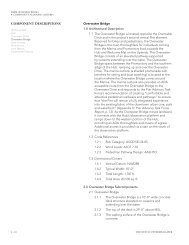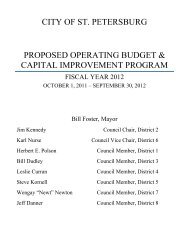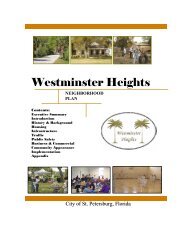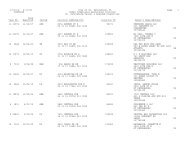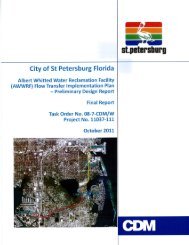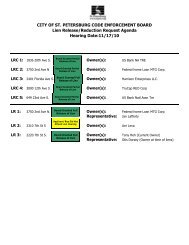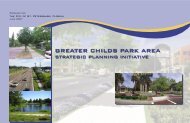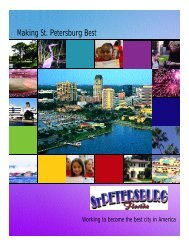Basis of Design Book 2 - City of St. Petersburg
Basis of Design Book 2 - City of St. Petersburg
Basis of Design Book 2 - City of St. Petersburg
Create successful ePaper yourself
Turn your PDF publications into a flip-book with our unique Google optimized e-Paper software.
Meeting with <strong>City</strong> Engineers 6/28<br />
A meeting was held at the Municipal Services Building with <strong>City</strong> Personnel and M<strong>of</strong>fatt<br />
& Nichol to discuss the project. In attendance were:<br />
<strong>City</strong> <strong>of</strong> <strong>St</strong>. <strong>Petersburg</strong> Engineering Department<br />
M<strong>of</strong>fatt & Nichol<br />
Michael Connors<br />
Thomas Gibson<br />
Raul Quintana<br />
Fred Dargahi<br />
Richard Herrmann<br />
Jeffrey Malyszek<br />
Mike Herrman<br />
The <strong>City</strong> Expressed concerns about the following aspects <strong>of</strong> the design <strong>of</strong> the new<br />
"Lens" Pier:<br />
1. Navigational Access: The <strong>City</strong> is interested in increasing regional boat traffic to the<br />
facility by enhancing and making safer the mooring provisions <strong>of</strong> the new Pier. The <strong>City</strong><br />
requested a Team visit to the "Bay Borough Marina" where they had observed efficient<br />
structural construction and a wave dissipater.<br />
2. Pier <strong>St</strong>ructure: The deck must be durable and be able to carry the loads required<br />
by emergency and maintenance vehicles. The <strong>City</strong> suggested that an AASHTO H-20<br />
load be applied to Pier structures, but Buro Happold stated that such load criteria could<br />
lead to a very expensive structure, and recommend that a conversation be initiated with<br />
emergency responders and maintenance personnel to define the access parameters<br />
needed.<br />
3. Canopy <strong>St</strong>ructure: The canopy structure must be durable as well, and resist uplift<br />
due to wind, wave forces at the base, the saline environment <strong>of</strong> the bay, and the intense<br />
UV exposure at this location. Such details as reinforcing bar cover and cathodic<br />
protection must be thoroughly vetted. Algae infestation and other weathering factors<br />
may change the "look" <strong>of</strong> the structure over time.<br />
4. Elevations: Various criteria will affect the finished elevations <strong>of</strong> Pier elements.<br />
These include FEMA 100-year flood plains, and a local ordinance that lowest horizontal<br />
members must be at least 1.0' above the Base Flood Elevation (BFE). The <strong>City</strong> will<br />
provide that elevation. The <strong>City</strong> also stated that the project shall be progressed in <strong>St</strong>.<br />
<strong>Petersburg</strong> <strong>City</strong> Datum, where elevation 97.0' is mean sea level.<br />
5. Geotechnical Information: The <strong>City</strong> had replaced 120' <strong>of</strong> the old Pier about 10<br />
years ago, using 16" diameter piles driven 60' into sandy soils. They did state that it<br />
took a few days for piles to achieve maximum capacity since, they said, they were<br />
friction piles and the soil needed to settle around the piles to achieve the required<br />
friction. Buro Happold requested that any existing boring or pile driving records be<br />
forwarded to the design team.<br />
Buro Happold stated that since the new structure will be narrower than the existing, that<br />
batter piles might be needed to resist lateral forces, since we will not have a multiplicity<br />
<strong>of</strong> vertical piles to generate lateral resistance.




